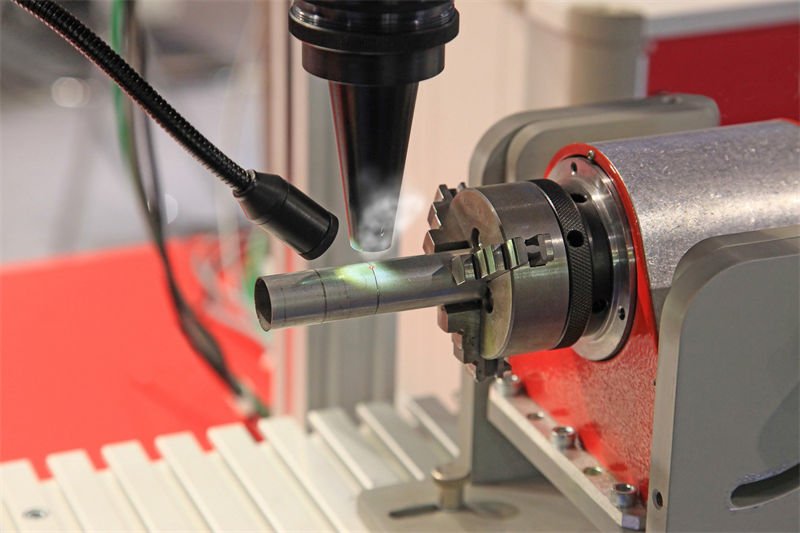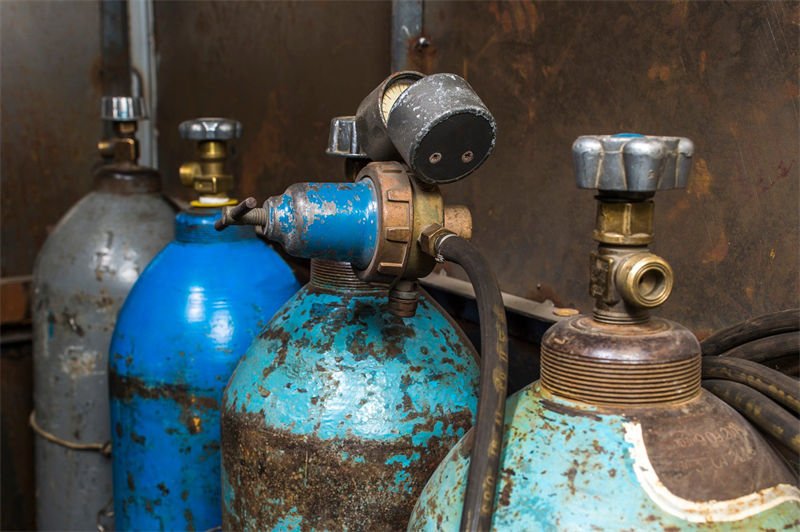
Welding can feel like an art form, where every decision impacts the final masterpiece. Among these decisions, choosing the right gas stands out as a key player in laser welding.
Argon is the essential gas for laser welding due to its inert properties that prevent oxidation and improve weld quality. It forms a protective barrier, ensuring that the weld area remains uncontaminated and retains its mechanical properties.
But wait—there’s more! Beyond argon, gases like helium, nitrogen, and carbon dioxide each bring unique strengths to the table. Let’s dive deeper into how these gases can transform your welding projects.
Argon is essential for laser welding.True
Argon's inert properties prevent oxidation, improving weld quality.
What Roles Do Helium and Nitrogen Play in Laser Welding?
Helium and nitrogen are vital gases in laser welding, each offering unique advantages. But what roles do they actually play?
Helium enhances weld penetration and arc stability in laser welding, especially for materials with high thermal conductivity, while nitrogen offers cost-effective protection for certain steels, potentially improving weld hardness and wear resistance.

Helium: The Powerhouse of High-Quality Welding
Helium is a popular choice for laser welding, particularly when high-quality welds are essential. As an inert gas, helium’s role extends beyond mere protection; its high ionization energy means it provides a wider arc voltage range, offering greater energy density. This makes helium ideal for welding metals with high thermal conductivity, such as copper or aluminum.
In practical terms, helium helps achieve deeper weld penetration and uniformity, crucial for applications requiring precision and strength, like aerospace and electronics. However, the higher cost of helium can be a deterrent for widespread use in large-scale industrial settings.
| Gas | Ionization Energy | Cost Implications |
|---|---|---|
| Helium | High | Expensive |
| Nitrogen | Medium | Affordable |
Nitrogen: A Cost-Effective Option for Specific Applications
Nitrogen, while more chemically active than helium, offers a cost-effective alternative in certain laser welding scenarios. Its use is generally reserved for metals that are not overly sensitive to nitrogen’s presence, such as low-carbon steel. Here, nitrogen acts as a protective gas that can enhance the hardness and wear resistance of the weld by forming nitrides.
However, caution is advised when using nitrogen for non-ferrous metals or high-alloy steels, as it can lead to weld embrittlement. In applications where cost is a significant factor and the material properties allow for it, nitrogen can provide adequate protection without compromising weld quality.
Choosing Between Helium and Nitrogen
The decision to use helium or nitrogen depends on several factors:
- Material Sensitivity: For materials highly sensitive to impurities, helium is preferable.
- Cost Considerations: When budget constraints are significant, nitrogen offers a cheaper alternative.
- Weld Requirements: If the weld requires high penetration and uniformity, helium is more suitable.
For further insights into choosing the right gas for your specific welding needs, consider exploring how different gases affect welding outcomes1. Understanding these nuances can significantly enhance your project’s success.
Helium provides a wider arc voltage range in laser welding.True
Helium's high ionization energy results in a wider arc voltage range.
Nitrogen is suitable for welding high-alloy steels.False
Nitrogen can cause embrittlement in high-alloy steels.
How Does Gas Flow Rate Affect Laser Welding Quality?
In laser welding, the flow rate of gas significantly impacts the quality and stability of the weld.
The gas flow rate in laser welding determines the effectiveness of shielding the weld area. Too low a flow allows air intrusion, leading to oxidation, while too high a flow creates turbulence, affecting the weld’s stability and appearance. An optimal flow rate is crucial for maintaining weld quality and preventing defects.

The Role of Gas Flow Rate in Weld Protection
In laser welding, maintaining an adequate protective shield over the weld area is paramount. This protective layer, formed by gases like argon or helium, prevents air from reaching the molten weld pool. A suboptimal gas flow rate can lead to air contamination. For instance, if argon’s flow is below 15L/min when welding aluminum, oxygen might infiltrate, causing oxidation and compromising the weld’s strength.
Impact on Welding Stability
Gas flow not only shields but also influences welding stability. In high-speed or high-power laser welding, a stable gas flow ensures consistent plasma formation and energy absorption. Consider welding copper, a metal with high thermal conductivity; an optimal helium flow stabilizes the arc and maintains uniform penetration.
Consequences of Imbalanced Flow Rates
An imbalanced gas flow rate can cause several issues:
- Insufficient Flow: Leads to poor shielding, oxidation, and nitride formation.
- Excessive Flow: Creates turbulence, destabilizing the molten pool and leading to defects such as pores.
Balancing Gas Flow with Welding Parameters
It’s essential to align gas flow with other welding parameters like speed and power. For example, in pulsed laser welding, synchronizing gas flow with pulse frequency ensures consistent protection throughout each pulse. Adjustments might include increasing flow during high-speed welding to maintain protection over the rapidly advancing weld zone.
Practical Examples and Adjustments
For practical application, consider these adjustments based on material and process requirements:
- Material Sensitivity: Metals sensitive to impurities (e.g., titanium) necessitate higher purity and controlled flow rates.
- Process Type: Continuous vs. pulsed processes may require different flow adjustments.
Table: Optimal Gas Flow Rates by Material
| Material | Recommended Gas | Optimal Flow Rate (L/min) |
|---|---|---|
| Aluminum | Argon | 15-25 |
| Copper | Helium | 20-30 |
| Stainless Steel | Argon | 10-20 |
Maintaining the correct gas flow rate2 is crucial for achieving high-quality welds. By understanding how different gases and their flow rates affect your specific welding process, you can enhance both the efficiency and quality of your laser welding applications.
Gas flow rate affects laser weld stability.True
Gas flow influences plasma formation and energy absorption, affecting stability.
Too high gas flow rate prevents oxidation.False
Excessive flow causes turbulence, not preventing oxidation effectively.
What Are the Cost Implications of Different Welding Gases?
Selecting the right welding gas can significantly impact your project budget. How do different gases affect costs?
Different welding gases have a significant impact on cost. Firstly, in terms of price, argon is expensive, carbon dioxide is low-priced, and mixed gases are in the middle. Secondly, the gas consumption rate varies depending on flow requirements and welding parameters. Unreasonable flow or parameters will increase costs. Moreover, gases affect welding quality and efficiency. High-quality gases reduce rework costs. Appropriate gases can improve efficiency and reduce overall costs, and vice versa.

Understanding the Cost of Common Welding Gases
In laser welding, selecting the appropriate gas is vital not only for achieving desired weld quality but also for managing project costs. Let’s examine how the costs of different gases can impact welding projects:
Argon: Balancing Cost and Quality
Argon is often the preferred choice for its inert properties that prevent oxidation and maintain weld quality. However, its cost can vary significantly based on purity levels. Industrial-grade argon (approximately 99% purity) typically costs between $7 and $20 per 40-liter bottle. In contrast, high-purity argon (99.99% or above) may range from $28 to $70 per bottle. While higher purity ensures better results, it also increases costs.
Helium: High Performance at a Price
Helium is prized for its high energy density and ability to handle high thermal conductivity materials like copper. However, this comes at a premium. Standard helium prices hover around $70 to $140 per 40-liter bottle, with high-purity options potentially exceeding $140. This elevated cost often limits helium’s use to applications where its benefits outweigh the financial impact.
Nitrogen and Carbon Dioxide: Budget-Friendly Alternatives
Nitrogen offers a more economical option, with prices ranging from $4 to $12 per 40-liter bottle for industrial-grade quality. Its use is generally confined to metals not sensitive to nitridation effects. Similarly, carbon dioxide is an affordable choice, costing around $4 to $8 per 40-liter bottle, making it ideal for reducing expenses in suitable applications.
Evaluating Mixed Gas Solutions
Sometimes, a mixture of gases is used to balance cost and performance. For example, combining helium and argon can be less expensive than using pure helium while still providing desirable welding characteristics. However, these mixtures require careful consideration of gas ratios and purity levels to ensure cost-effectiveness without compromising quality.
| Gas Type | Price Range (40L) | Purity Consideration |
|---|---|---|
| Argon | $7 – $70 | Higher purity = higher cost |
| Helium | $70 – $140+ | High-performance applications only |
| Nitrogen | $4 – $12 | Best for non-sensitive metals |
| Carbon Dioxide | $4 – $8 | Suitable for cost-reduction goals |
Understanding the interplay between gas choice and cost allows manufacturers to make informed decisions that align with both quality and budgetary constraints.
For further reading on optimizing gas selection in laser welding, explore resources like gas selection strategies3 and cost management in industrial welding4.
Argon is the most expensive welding gas.False
Helium is more expensive than argon, costing up to $140+.
Nitrogen is suitable for non-sensitive metals.True
Nitrogen is economical and used for metals not sensitive to nitridation.
Can Mixed Gases Improve Laser Welding Efficiency?
Mixing gases in laser welding can significantly enhance efficiency and weld quality. But how do these combinations work?
Mixed gases in laser welding improve efficiency by optimizing energy density, arc stability, and metallurgical properties. By combining gases like argon, helium, and nitrogen, welders can achieve deeper penetration, reduced oxidation, and enhanced mechanical properties, tailoring the welding environment to specific materials and requirements.

Understanding Gas Combinations in Laser Welding
In the realm of laser welding, the right combination of gases can drastically alter the welding environment, leading to improved efficiency and better weld quality. By mixing gases, welders can fine-tune properties such as energy density and arc stability to suit specific materials and applications.
Argon-Helium Mix: Enhancing Penetration
An argon-helium mix5 is particularly effective for metals with high thermal conductivity. Helium, with its high ionization energy, enhances penetration depth, while argon stabilizes the arc. This combination is ideal for materials like copper and aluminum where deep penetration and stable arcs are crucial.
Argon-Nitrogen Mix: Improving Mechanical Properties
When aiming to boost hardness and wear resistance, an argon-nitrogen mix6 can be beneficial. Nitrogen interacts with certain metals to form nitrides in the weld seam, improving mechanical properties. This mix is suitable for carbon steel where slight nitrogen presence can enhance weld characteristics without causing embrittlement.
Argon-Carbon Dioxide Mix: Balancing Cost and Quality
For cost-sensitive projects, an argon-carbon dioxide mix7 offers a balanced approach. Carbon dioxide increases molten pool fluidity and arc stability while maintaining reasonable costs. This mix is often used in automotive manufacturing where efficiency and cost-effectiveness are priorities.
The Role of Multiple Gas Mixtures
Complex welding tasks often require a triple-gas mixture8 involving argon, helium, and nitrogen. Such combinations can meet high-quality requirements by leveraging the unique properties of each gas. Helium provides penetration, argon stabilizes the arc, and nitrogen adjusts metallurgical properties.
Choosing the Right Gas Mix
The selection of a suitable gas mix depends on several factors including material type, welding process, and cost considerations. Extensive testing is often required to determine the optimal mixture for achieving desired results. Factors such as weld appearance, mechanical strength, and chemical composition play a role in refining these mixtures.
Argon-helium mix increases penetration depth in welding.True
Helium's high ionization energy enhances penetration, while argon stabilizes the arc.
Nitrogen in welding gas mixes causes embrittlement in all metals.False
Nitrogen can enhance properties without embrittlement, especially in carbon steel.
Conclusion
In the world of laser welding, selecting the right gas is pivotal for achieving optimal results. Reflect on your materials, processes, and budget to make informed choices that will elevate your work.
-
Learn about the impact of various gases on welding quality.: Shielding gases with greater reactivity, which use more CO2 or O2, will increase weld pool fluidity. For out-of-position work, this may force … ↩
-
Discover specific recommendations for gas flow rates in various laser welding applications.: Argon is one of the most widely used shielding gases in laser welding. It offers excellent plasma suppression, preventing unwanted sparks and … ↩
-
Explore strategies for optimal gas selection in welding.: The most frequently used shield gases for laser welding are helium, argon, and nitrogen. 1. Argon gas is cheaper and denser, so the protective effect is better. ↩
-
Learn how to manage welding costs effectively.: 8 ways to reduce the cost for welding operations · 1. Don’t Change Consumables Too Soon · 2. Control Consumable Usage to Reduce the Cost of … ↩
-
Explore how argon-helium mixes enhance weld penetration.: It has superior heat transfer capabilities compared to argon, making it ideal for high-power laser applications. Helium also provides good … ↩
-
Learn about improving weld mechanical properties with argon-nitrogen.: The nitrogen acts as an austenitic stabilizer. A 95 percent argon/5 percent nitrogen mix typically works best. ↩
-
Discover cost-effective welding solutions using argon-carbon dioxide.: Argon Carbon Dioxide blends are versatile mixtures for welding carbon, low-alloy and some stainless steels. Increasing the CO2 content will increase weld … ↩
-
Understand how multiple gases improve complex welding tasks.: Shielding gas acts as a protective barrier between the weld pool and the surrounding environment, preventing oxidation and contamination during the fusion … ↩




